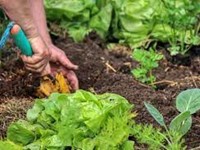Get Gardening Without Causing Pain
BlogImage
As the weather warms up, more people want to spend more time working in their garden. There’s a lot to do when setting up your garden – digging, raking, planting, pruning, lifting and moving – and it’s important to make sure you can do all that without causing yourself pain. Gardening is a great way to stay active and enjoy the outdoors, but it can also be hard on your body causing musculoskeletal pain. These tips can help you tend to your garden without putting yourself out of commission.
Do a Warm Up
By warming up prior to gardening, you’ll help prevent future gardening injuries. This would be similar to warming up before playing a sport. You can start with a brisk 5 minute walk, and can also include targeted stretching to help prevent back pain, shoulder pain and other types of pain.
Some simple stretches you can do to prevent gardening aches and pains include:
Slow shoulder rolls. First ensure your shoulders are back and down. Then, one at a time, gently roll each one by first lifting it up and then back and down into a more comfortable position.
Wrist stretches. It can be beneficial to stretch your wrists before gardening. First hold your right arm out at shoulder height. Keep your elbow straight and with your left hand, slowly bend you wrist backward until you feel a stretch along the bottom of your forearm. Hold for 15 seconds. Then bend wrist downward until a stretch is felt on the top of the arm, and hold for 15 seconds. Switch arms and repeat. You should repeat four times on each hand.
Stand Tall Like a Tree. Start standing with your feet shoulder width apart. Reach your arms above your head as far as you can comfortably while keeping them shoulder width apart, like you’re a tree reaching your branches as high as you can. Slowly sway your arms to the left while keeping your lower body in a stationary position, hold there for five seconds and then sway your body to the right and repeat. Stretch five times in each direction.
Stretch your sides. Extend your right arm over your head and bend at the waist towards the left. Hold for 15 seconds and then repeat on the other side. Repeat this stretch three times on each side.
These are just some of the stretches that can help you warm up for a day of gardening. Remember, stretches should be gentle and shouldn’t cause you pain.
Make things easier and enjoy the benefits
You can use tools to make transporting materials easier, like a cart or trolley when moving heavy pots or bags of soil. You can also use a low stool rather than squatting close to the ground or kneeling to avoid knee or back injury and to make things easier. Long-handled tools with easy-to-grip handles also enable you to extend your reach while sitting or working in your garden while standing. Sharpen any dull blades or edges on tools like shears, trowels, and hoes so they’re easier to use- carefully!
By limiting the risk of injury, you will be better able to enjoy the many benefits of gardening which include potential improved dexterity and strength. Gardening also offers an opportunity for exercise, and exercise is a great way to decrease pain and improve function if you have musculoskeletal pain.
Plan Your Day and Change it Up
Gardening can be a work out, so start your day of gardening when you’re feeling ready for some exercise. Decide how long you want to be gardening and don’t push yourself past your limits. If you try to pack too much in one day you might end up doing more than your body can handle at the moment.
It’s also best if you didn’t stick to the same task for too long as maintaining an awkward posture too long, whether it’s sitting, standing, weeding or raking, can lead to pain. You can change activities every 30 minutes or so, like going from raking to planting, to help prevent injury. Switching activities frequently will also help you avoid repetitive-motion injuries.
Take a Break When You Need To
You may feel tempted to complete a big gardening project all at once; pushing yourself beyond your limits can lead to future injury. Make sure to take regular breaks at least every hour, stay hydrated and don’t be afraid to ask for help if you need it. Gardening can be hard work for your body, and working too long along with the repetitive movements that gardening requires can lead to injury, so taking a break is important!
If you are experiencing a gardening injury that is preventing you from continuing to enjoy your garden, ask your RMT how they can help!
To find an RMT near you, visit RMTFind.com.
References
Geneen, L. J., Moore, R. A., Clarke, C., Martin, D., Colvin, L. A., & Smith, B. H. (2017). Physical activity and exercise for chronic pain in adults: an overview of Cochrane Reviews. The Cochrane database of systematic reviews, 1(1), CD011279.
Sitthipornvorakul, E., Janwantanakul, P., Purepong, N., Pensri, P., & van der Beek, A. J. (2011). The association between physical activity and neck and low back pain: a systematic review. European spine journal : official publication of the European Spine Society, the European Spinal Deformity Society, and the European Section of the Cervical Spine Research Society, 20(5), 677–689.
Soares, C. O., Pereira, B. F., Pereira Gomes, M. V., Marcondes, L. P., de Campos Gomes, F., & de Melo-Neto, J. S. (2020). Preventive factors against work-related musculoskeletal disorders: narrative review. Revista brasileira de medicina do trabalho : publicacao oficial da Associacao Nacional de Medicina do Trabalho-ANAMT, 17(3), 415–430.
Thompson R. (2018). Gardening for health: a regular dose of gardening. Clinical medicine (London, England), 18(3), 201–205.


